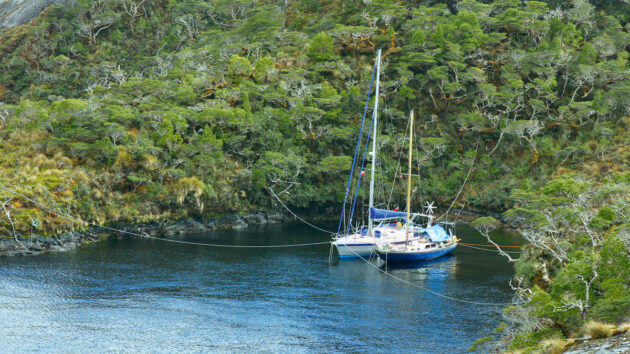Understanding the Use of Shore Lines
Securing a boat at anchor with a shore line can be a brilliant way to enhance stability and safety, especially in certain environments. This practical technique allows for more control over your vessel, optimizing your anchoring experience and ensuring a secure stay while enjoying your surroundings.
Why Use Shore Lines?
Utilizing shore lines offers several advantages. In regions with deep waters, such as Patagonia, anchoring closer to the shore can sometimes be necessary due to geography. The accessibility to picturesque and safe anchorages is one of the significant benefits of using this method.
This is particularly crucial when exploring areas with limited swinging room. In cases where surrounding depths may change dramatically with the tide, attaching a line to the shore can keep your vessel safely anchored in position, preventing it from drifting due to tidal fluctuations.
In popular locations such as the Aegean Sea or the Baltic, the practice of using shore lines is quite common. Boats can fit snugly together without risk of collision, allowing for a more enjoyable and less stressful experience.
Potential Benefits of Using Shore Lines
- Increased Stability: Keeps the boat from swinging in strong currents, allowing for quiet nights aboard.
- Optimized Space: Multiple boats can moor closely without hindrance.
- Improved Safety: Reduces the risk of entanglement with underwater obstacles.
- Easy Access: Simplifies getting to shore via a dinghy by providing a secure way to pull your small craft in.
The Versatility of Shore Lines
Shore lines aren’t solely for tight spots; they can also be employed in open bays where swell can create an uncomfortable situation at anchor. If conditions change—like a shift from an offshore breeze to a calm night—a boat could turn broadside to waves. A shore line can make all the difference in maintaining a favorable position, keeping the vessel’s bow pointed into choppy waters.
Sometimes a kedge anchor can be practical for the same effect, but using shore lines extends options, providing peace of mind, particularly in exposed anchorages. In storms or unpredictable weather, they can offer critical security, helping to keep the boat steady and secure despite challenging conditions.
Essential Equipment and Materials
When using shore lines, adequate rope selection is crucial. A longer line is preferable; in places like Patagonia, lengths of 100 meters are common. Floating rope is advantageous to avoid snags on underwater debris, and braided rope generally handles better than twisted types.
Additionally, protective gear like rock wedges and loops of chain at the line’s end can help prevent wear and damage when tying off to solid surfaces, such as rocks. These preparations ensure safety and durability during your boating adventures.
Mooring Procedure: Step-by-Step
Every anchoring situation is unique, but there are general steps to follow when securing your boat with a shore line:
- Anchor Normally: Allow plenty of chain to provide secure holding.
- Assess Position: Once you are secure, prepare the tender to take the line ashore quickly.
- Launch the Dinghy: This could also include paddleboards for efficiency, especially in windy conditions.
- Secure the Shore Line: Tie to a tree, rock, or other solid structure close to the shoreline.
- Tighten as Needed: Adjust slack to ensure proper tension without compromising effectiveness.
Common Challenges and Considerations
When using shore lines, watch for potential problems. Changes in wind direction can hinder your boat’s free swinging, which might complicate your position. Most importantly, safety precaution should remain a priority; consider any hidden underwater obstacles that could present risks.
Additionally, don’t ignore the presence of other boats and ensure that your mooring line is visible to avoid confusion or accidents. Keeping your shore line organized will ensure a smooth experience for everyone involved.
Storage Solutions for Shore Lines
When frequently using shore lines, accessibility is key. Storing this equipment on deck in dedicated containers will save time and streamline the process when it’s time to set anchors. Some sailors advocate for utilizing easy-drain containers, keeping ropes well organized, and preventing tangling.
A Final Note on Boat Rentals
Inviting a new experience with shore lines into your boating repertoire is exciting, especially if exploring hidden anchorages. Imagine finding an idyllic spot that may not be on the pilot’s radar. It’s an opportunity to discover new vistas and the serenity of marine nature.
In a world where each bay, inlet, and lagoon tells a story, venturing into the sea becomes a profound journey. When planning the next seaside adventure, consider the freedom that comes from boat rentals. The options available, whether you’re renting a yacht or a smaller craft, offer an unparalleled way to connect with the surrounding nature, the ocean’s rhythm, and local culture. Explore diverse and unique destinations through GetBoat.com and redefine your nautical experiences.
By incorporating these shoreline techniques into your anchoring practices, you’re likely to maximize your unforgettable adventures at sea. Remember, optimizing the use of shore lines doesn’t only contribute to the technicalities of anchoring but also ensures a rewarding connection with the areas near the water while experiencing the diverse culture along your journey.
In the end, utilizing shore lines is not just about securing a boat; it’s about enhancing the overall sailing experience, allowing the captain and crew to explore the ocean’s beauty while retreating to a stable respite. This freedom echoes the values at GetBoat, where customers can find a vessel suited to any taste or budget, creating unforgettable memories on the open seas.


